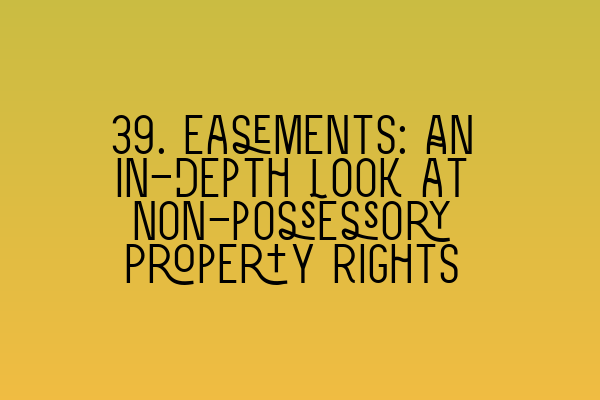39. Easements: An In-Depth Look at Non-possessory Property Rights
As a property law solicitor at SQE Property Law & Land Law, I have encountered numerous cases involving easements. Easements are non-possessory property rights that allow one person (the dominant owner) to use the land of another person (the servient owner) for a specific purpose. In this blog post, we will delve into the intricacies of easements, exploring their definition, characteristics, creation, and termination. So, let’s dive in and explore this fascinating aspect of property law.
Defining Easements
An easement is a legally recognized right that grants the dominant owner certain privileges over the servient owner’s land. These privileges typically involve the use or enjoyment of the land and can include rights of way, rights to access utilities, rights to light and air, and rights to support.
Characteristics of Easements
Easements possess several distinct characteristics that set them apart from other property rights. These characteristics are essential to understanding the nature and scope of easements:
- Non-possessory: Unlike ownership or leasehold interests, easements do not confer possession or exclusive occupation of the land. The servient owner retains legal control and possession of the land.
- Attached to the land: Easements are attached to the land, meaning they run with the land and are enforceable against subsequent owners of both the dominant and servient tenements.
- Indefinite duration: Easements are generally perpetual and do not expire over time unless explicitly terminated.
- Specificity: Easements are specific in nature and define the precise rights granted to the dominant owner. The scope and extent of the easement must be clearly defined and should not be vague or ambiguous.
Creating an Easement
Easements can be created through various means, including express grant, implied grant, prescription, and necessity.
- Express grant: An easement can be expressly granted by the servient owner through a written agreement known as a deed.
- Implied grant: An easement may be implied if it is necessary for the reasonable use and enjoyment of the dominant land and was intended to be granted when the land was originally divided.
- Prescription: A prescriptive easement can be acquired through long and uninterrupted use of another’s land without permission. The use must be open, continuous, exclusive, and without the servient owner’s consent for a specified period of time.
- Necessity: Easements by necessity arise when access to a landlocked property can only be obtained by crossing another’s land. This typically occurs when a landowner subdivides a larger tract of land, leaving one portion without direct access to a public road.
Terminating an Easement
Easements can be terminated in several ways, including express release, abandonment, expiration, merger, and prescription.
- Express release: The dominant and servient owners can agree to release the easement through a written agreement.
- Abandonment: If the dominant owner demonstrates a clear intention to abandon the easement and ceases using it for an extended period of time, it may be deemed terminated.
- Expiration: An easement created for a specific duration, such as a temporary right of access during construction, will naturally terminate upon reaching its expiration date.
- Merger: If the dominant and servient tenements come under the same ownership, the easement may be extinguished by merger.
- Prescription: If the servient owner interferes with the easement continuously and without permission for a specified period of time, the easement may be terminated through prescription.
Conclusion
Easements play a crucial role in property law, balancing the rights of different landowners and allowing for the efficient use and enjoyment of land. Understanding the definition, characteristics, creation, and termination of easements is essential for both legal professionals and property owners.
If you found this article informative, we recommend checking out these related articles for further insight and preparation:
- SQE 1 Practice Exam Questions
- SQE 1 Practice Mocks FLK1 FLK2
- SQE 2 Preparation Courses
- SQE 1 Preparation Courses
- SRA SQE Exam Dates
At SQE Property Law & Land Law, our team of experienced solicitors can provide expert advice and assistance with any easement-related matters. Contact us today to schedule a consultation or to learn more about our comprehensive property law services.
Disclaimer: The information provided in this blog post is for general informational purposes only and does not constitute legal advice. Please consult with a qualified solicitor for advice tailored to your specific circumstances.
